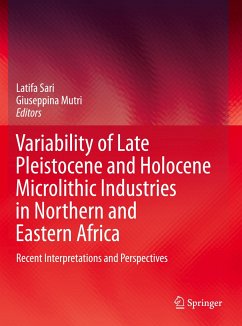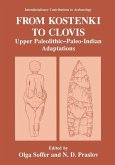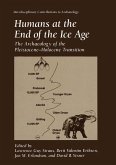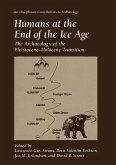Variability of Late Pleistocene and Holocene Microlithic Industries in Northern and Eastern Africa
Recent Interpretations and Perspectives
Herausgegeben:Sari, Latifa; Mutri, Giuseppina
Variability of Late Pleistocene and Holocene Microlithic Industries in Northern and Eastern Africa
Recent Interpretations and Perspectives
Herausgegeben:Sari, Latifa; Mutri, Giuseppina
- Broschiertes Buch
- Merkliste
- Auf die Merkliste
- Bewerten Bewerten
- Teilen
- Produkt teilen
- Produkterinnerung
- Produkterinnerung
This book addresses the question of variability in backed bladelet-based technologies. It also examines the role of LSA microlithic industries as adaptive strategies for coping with paleoenvironmental changes in North Africa. The multidisciplinary research activities conducted in caves and open-air sites in North Africa over the past two decades have highlighted the importance of this region for understanding the development of LSA microlithic technologies in Africa. This book, therefore, enriches the debate of origin and the spread of Late Pleistocene microlithic technologies in North Africa…mehr
Andere Kunden interessierten sich auch für
![Variability of Late Pleistocene and Holocene Microlithic Industries in Northern and Eastern Africa Variability of Late Pleistocene and Holocene Microlithic Industries in Northern and Eastern Africa]() Variability of Late Pleistocene and Holocene Microlithic Industries in Northern and Eastern Africa97,99 €
Variability of Late Pleistocene and Holocene Microlithic Industries in Northern and Eastern Africa97,99 €![Droughts, Food and Culture Droughts, Food and Culture]() Fekri A. Hassan (ed.)Droughts, Food and Culture83,99 €
Fekri A. Hassan (ed.)Droughts, Food and Culture83,99 €![From Kostenki to Clovis From Kostenki to Clovis]() From Kostenki to Clovis125,99 €
From Kostenki to Clovis125,99 €![Droughts, Food and Culture Droughts, Food and Culture]() Droughts, Food and Culture83,99 €
Droughts, Food and Culture83,99 €![Encyclopedia of Prehistory Encyclopedia of Prehistory]() Peter N. Peregrine / Melvin Ember (Hgg.)Encyclopedia of Prehistory125,99 €
Peter N. Peregrine / Melvin Ember (Hgg.)Encyclopedia of Prehistory125,99 €![Humans at the End of the Ice Age Humans at the End of the Ice Age]() Lawrence Guy Straus / Berit Valentin Eriksen / Jon M. Erlandson / David R. Yesner (Hgg.)Humans at the End of the Ice Age125,99 €
Lawrence Guy Straus / Berit Valentin Eriksen / Jon M. Erlandson / David R. Yesner (Hgg.)Humans at the End of the Ice Age125,99 €![Humans at the End of the Ice Age Humans at the End of the Ice Age]() Humans at the End of the Ice Age125,99 €
Humans at the End of the Ice Age125,99 €-
-
-
This book addresses the question of variability in backed bladelet-based technologies. It also examines the role of LSA microlithic industries as adaptive strategies for coping with paleoenvironmental changes in North Africa. The multidisciplinary research activities conducted in caves and open-air sites in North Africa over the past two decades have highlighted the importance of this region for understanding the development of LSA microlithic technologies in Africa. This book, therefore, enriches the debate of origin and the spread of Late Pleistocene microlithic technologies in North Africa and beyond.
Previously published in African Archaeological Review Volume 37, issue 3, September 2020
Previously published in African Archaeological Review Volume 37, issue 3, September 2020
Produktdetails
- Produktdetails
- Verlag: Springer / Springer Nature Switzerland / Springer, Berlin
- Artikelnr. des Verlages: 978-3-031-18205-1
- 1st edition 2022
- Seitenzahl: 212
- Erscheinungstermin: 23. November 2023
- Englisch
- Abmessung: 260mm x 193mm x 12mm
- Gewicht: 454g
- ISBN-13: 9783031182051
- ISBN-10: 3031182057
- Artikelnr.: 69225967
- Herstellerkennzeichnung Die Herstellerinformationen sind derzeit nicht verfügbar.
- Verlag: Springer / Springer Nature Switzerland / Springer, Berlin
- Artikelnr. des Verlages: 978-3-031-18205-1
- 1st edition 2022
- Seitenzahl: 212
- Erscheinungstermin: 23. November 2023
- Englisch
- Abmessung: 260mm x 193mm x 12mm
- Gewicht: 454g
- ISBN-13: 9783031182051
- ISBN-10: 3031182057
- Artikelnr.: 69225967
- Herstellerkennzeichnung Die Herstellerinformationen sind derzeit nicht verfügbar.
Master of Research A qualified in Prehistory at the National Center for Prehistoric, Anthropological and Historical Research of Algiers (CNRPAH). Member of the office of the North Africa Commission of the UISPP since 2017 and of the Pan-African Association of Archaeology, Prehistory and Associated Disciplines (PanAf) since 2018. Having always been interested in prehistoric lithic industries and human evolution , she obtained a Magister in prehistory at the Institute of Archeology of Algiers and subsequently enrolled at the University of Paris-Ouest Nanterre la Défense in Paris to prepare a doctoral thesis defended in 2012 on the industries lithics from the Iberomaurusian of Algeria (final Pleistocene culture of the Maghreb and which coincides with many microlaminar technocomplexes of the North of the Mediterranean such as the Epigravettian and the Azilian). His thesis represents the first evaluation of the variability of the Iberomaurusian lithic industries based on thetechnological approach which owes much to the impetus of Jacques Tixier. Giuseppina Mutri is currently Post Doc Fellow at the Cyprus Institute, where she is in charge of the study of dental calculus from different periods. Her previous research background focused on lithic technology and use-wear. Her experience on North African Prehistory began with her graduate dissertation on the lithic technology of the Upper Later Stone Age of Jebel Gharbi (Libya), where she also conducted extensive surveys for her PhD, working on the sourcing and characterization of lithic raw material for the same period.
SPECIAL ISSUE.- Diachronic Variation in Microlith Production Systems During the Late Pleistocene, Algeria.- Iberomaurusian Lithic Assemblages at Ifri El Baroud (Northeast Morocco).- The Early Holocene Lithic Tradition of the Northern Farafra Plateau (Tenth-Ninth Millennia cal BP): Its Significance in the Egyptian Western Desert.- Correction to: The Early Holocene Lithic Tradition of the Northern Farafra Plateau (Tenth-Ninth Millennia cal BP): Its Significance in the Egyptian Western Desert.- Common Cultural Markers in the Bone and Lithic Production of the Upper Capsian: A Comparative Approach.- Backed Pieces and Their Variability in the Later Stone Age of the Horn of Africa.- Jacques Tixier, 1925-2018.- The COVID-19 Pandemic: Perspectives for Reimaging and Reimagining Archaeological Practice.- Archaeology of Two Pandemics and Teranga Aesthetic.- Amy ty lilin-draza'ay: Building Archaeological Practice on Principles of Community.- Disease as a Factor in the African Archaeological Record.- Dark Side Archaeology: Climate Change and Mid-Holocene Saharan Pastoral Adaptation.- Managing Epidemics in Ancestral Yorùbá Towns and Cities: "Sacred Groves" as Isolation Sites.- Issues Emerging: Thoughts on the Reflective Articles on Coronavirus (COVID-19) and African Archaeology.- Tertia Barnett: An Engraved Landscape: Rock Carvings in the Wadi al-Ajal, Libya.- David M. Witelson: A Painted Ridge: Rock Art and Performance in the Maclear District, Eastern Cape, South Africa.- Sada Mire: Divine Fertility: The Continuity in Transformation of an Ideology of Sacred Kinship in Northeast Africa.- Aribidesi Usman and Toyin Falola: The Yoruba from Prehistory to the Present.- Wazi Apoh: Revelations of Domination and Resilience: Unearthing the Buried Past of the Akpini, Akan, Germans, and British at Kpando, Ghana.
SPECIAL ISSUE.- Diachronic Variation in Microlith Production Systems During the Late Pleistocene, Algeria.- Iberomaurusian Lithic Assemblages at Ifri El Baroud (Northeast Morocco).- The Early Holocene Lithic Tradition of the Northern Farafra Plateau (Tenth-Ninth Millennia cal BP): Its Significance in the Egyptian Western Desert.- Correction to: The Early Holocene Lithic Tradition of the Northern Farafra Plateau (Tenth-Ninth Millennia cal BP): Its Significance in the Egyptian Western Desert.- Common Cultural Markers in the Bone and Lithic Production of the Upper Capsian: A Comparative Approach.- Backed Pieces and Their Variability in the Later Stone Age of the Horn of Africa.- Jacques Tixier, 1925-2018.- The COVID-19 Pandemic: Perspectives for Reimaging and Reimagining Archaeological Practice.- Archaeology of Two Pandemics and Teranga Aesthetic.- Amy ty lilin-draza'ay: Building Archaeological Practice on Principles of Community.- Disease as a Factor in the African Archaeological Record.- Dark Side Archaeology: Climate Change and Mid-Holocene Saharan Pastoral Adaptation.- Managing Epidemics in Ancestral Yorùbá Towns and Cities: "Sacred Groves" as Isolation Sites.- Issues Emerging: Thoughts on the Reflective Articles on Coronavirus (COVID-19) and African Archaeology.- Tertia Barnett: An Engraved Landscape: Rock Carvings in the Wadi al-Ajal, Libya.- David M. Witelson: A Painted Ridge: Rock Art and Performance in the Maclear District, Eastern Cape, South Africa.- Sada Mire: Divine Fertility: The Continuity in Transformation of an Ideology of Sacred Kinship in Northeast Africa.- Aribidesi Usman and Toyin Falola: The Yoruba from Prehistory to the Present.- Wazi Apoh: Revelations of Domination and Resilience: Unearthing the Buried Past of the Akpini, Akan, Germans, and British at Kpando, Ghana.








